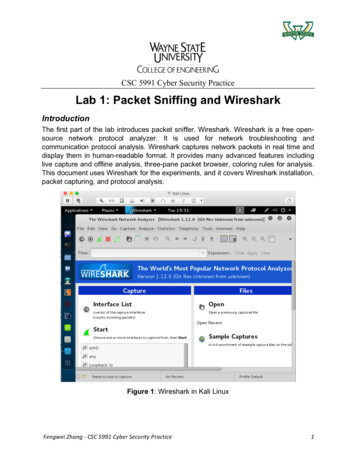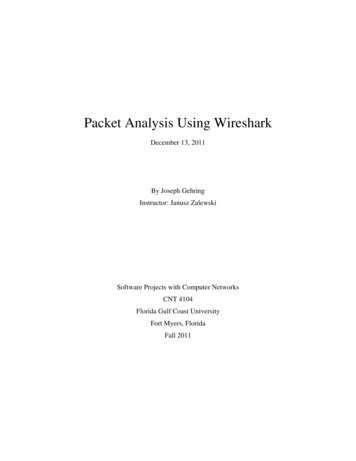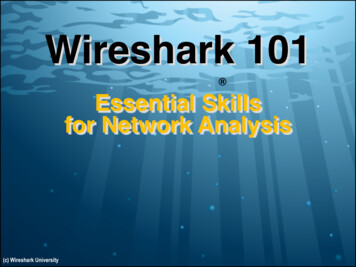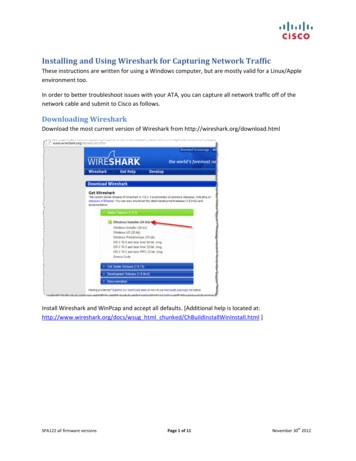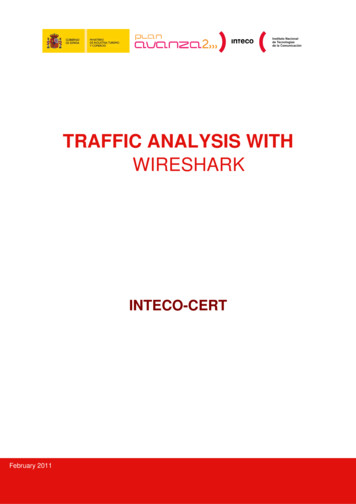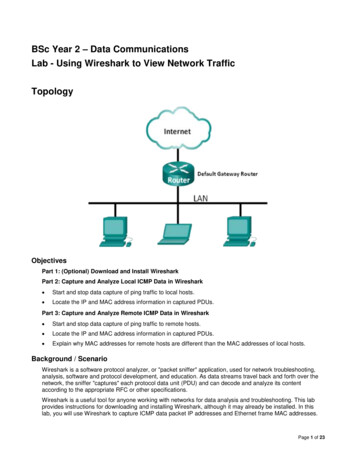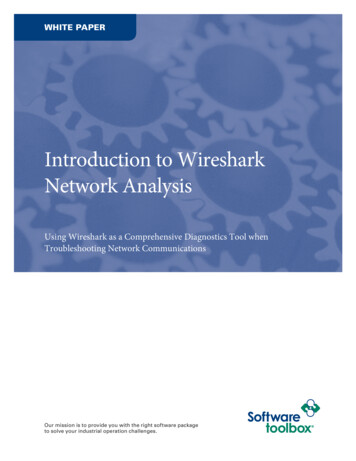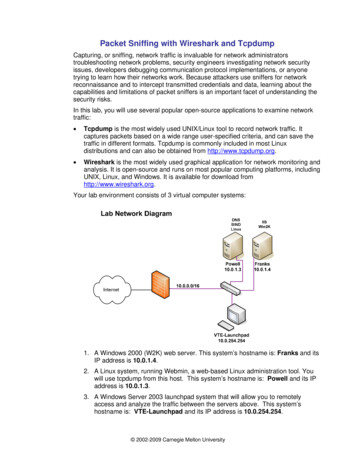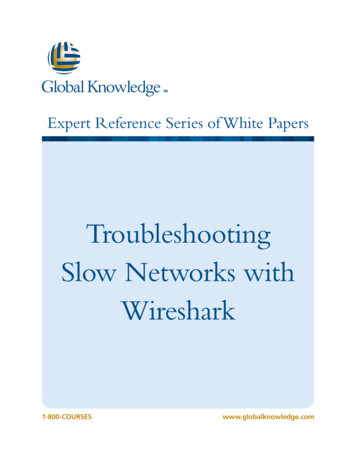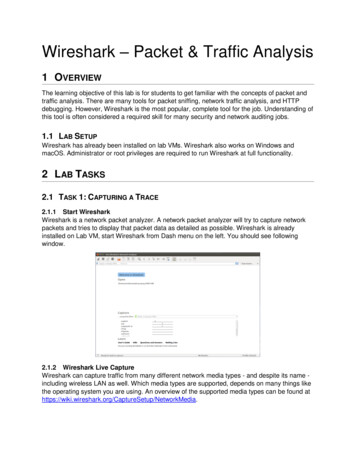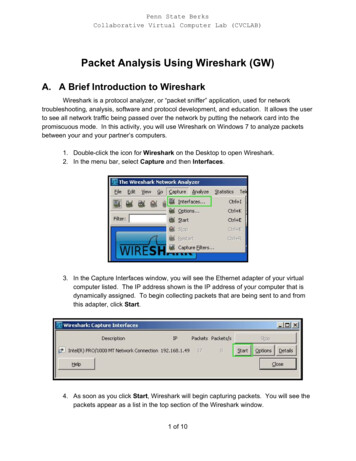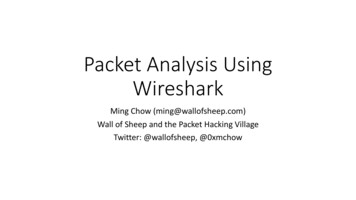
Transcription
Packet Analysis UsingWiresharkMing Chow (ming@wallofsheep.com)Wall of Sheep and the Packet Hacking VillageTwitter: @wallofsheep, @0xmchow
About the Wall of Sheep and the PacketHacking Village Our mission: security awareness How we accomplish our mission: interactive demonstrations,unconventional methods Our team: all volunteers
What is Packet Analysis? Look at and understand network traffic Also known as analyzing packets, also known as network trafficanalysis, also known as packet sniffing, also known as protocolanalysis, also known as packet tracing
Why Packet Analysis? Troubleshoot networking issues Record communications (e.g., email, voice, chat) Record and analyze web traffic Reconstruct images and other data transmitted on network Catch usernames and passwords, personal information, and othersensitive information that were sent insecurely, in plaintext
Source: scam-brought-down-theinternet/
What is a Packet? A unit of data A data stream (e.g., video, a web page) is comprised of many packets In general, a single packet contains the following information: Source and destination IP addresses and portsMAC addressTime To Live (TTL)Protocol (e.g., TCP, UDP, IMCP)Payload A packet encapsulates all layers of the Open Systems Interconnection(OSI) model
What is the OSI Model? “A conceptual framework thatdescribes the functions of anetworking or telecommunicationsystem.” 7 layers Each layer is abstracted from theother Sources: ember-the-7-layer-networkmodel.html osi-model/
What is a PCAP File? PCAP stands for “packet capture” .pcap: The common file extension for packet captures and iscommonly used in many applications such as Wireshark A 100 MB PCAP file contains tens of thousands of packets
What is Wireshark? Graphical and extensive packet analyzer Open source and free Platform independent (Windows, macOS, and Linux versionsavailable) Features include filtering, reconstructing conversations,reconstructing files based on packets Website: https://www.wireshark.org/
The Wireshark User Interface
Exercise 1: Opening a Simple PCAP File inWireshark Download: https://www.cs.tufts.edu/comp/116/simple.pcap Question 1: How many packets are there? Question 2: What networking protocol is used? Question 3: What is the source IP address? Question 4: What is the destination IP address? Question 5: What port number is the source using to communicatewith the destination (or what port number is the destination listeningon)? BONUS: Do you notice the “three-way handshake”?
Reconstructing a Conversation in Wireshark1. Click on a packet (it will behighlighted in blue)2. Right-click on packet3. Go to “Follow”4. Follow one of the followingstreams depending onprotocol (TCP Stream is mostcommon)
Exercise 2: Extracting Pictures Download: https://www.cs.tufts.edu/comp/116/set1.pcap Question 1: What insecure protocol was used to transmit pictures onnetwork? Question 2: How many pictures were transmitted? Question 3: Extract one of the pictures that was transmitted. HINT:show and save the picture as “Raw” format.
Base64 Base64 is an encoding scheme Used to represent binary data in ASCII text format Base64 is not encryption. Base64 is not encryption. Base64 is notencryption. Base64 is not encryption. Base64 is not encryption. Base64 isnot encryption. Base64 is not encryption. Base64 is not encryption. Base64is not encryption. Base64 is not cryption Why is this important? “In basic HTTP authentication, a request contains aheader field of the form Authorization: Basic credentials , where credentials is the Base64 encoding of id andpassword joined by a colon.” (source:https://en.wikipedia.org/wiki/Basic access authentication)
Exercise 3: Extracting Username:PasswordPairs Download: https://www.cs.tufts.edu/comp/116/set3.pcap Question 1: What protocol was used to transmit theusername:password pair (credentials)? Question 2: What is one username:password pair in this PCAP set?HINT: use Edit Find Packet Question 3: Is the username:password pair valid? Why / why not?
Where Do You Go From Here? Sniff and validate passwords Reconstruct files (e.g., images, MP3s) Volunteer at the Wall of Sheep and the Packet Hacking Village Learn more at our Packet Inspector event Further develop your skills at our Packet Detective ctive Enter Capture The Packet, a DEF CON Black Badge contest
(If time allows) Exercise 4: ExtractingUsername:Password Pairs Download: https://www.cs.tufts.edu/comp/116/set2.pcap This PCAP set is from the DEF CON conference. I am not responsiblefor the contents in this PCAP set. Question 1: How many packets are there in this PCAP set? Question 2: Find all the credentials in this PCAP set Question 3: Are the credentials valid? BONUS: Provide a list of all the domains and IP addresses in this PCAPset
Appendix: What is tshark? Command-line-based Wireshark Installed with Wireshark Dumps and analyzes network traffic Example, list the hosts (IP addresses and domains) in the PCAP file tshark -r file.pcap -q -z hosts,ipv4
Why Packet Analysis? Troubleshoot networking issues Record communications (e.g., email, voice, chat) Record and analyze web traffic Reconstruct images and other data transmitted on network Catch usernames and passwords, personal information, and other sens
